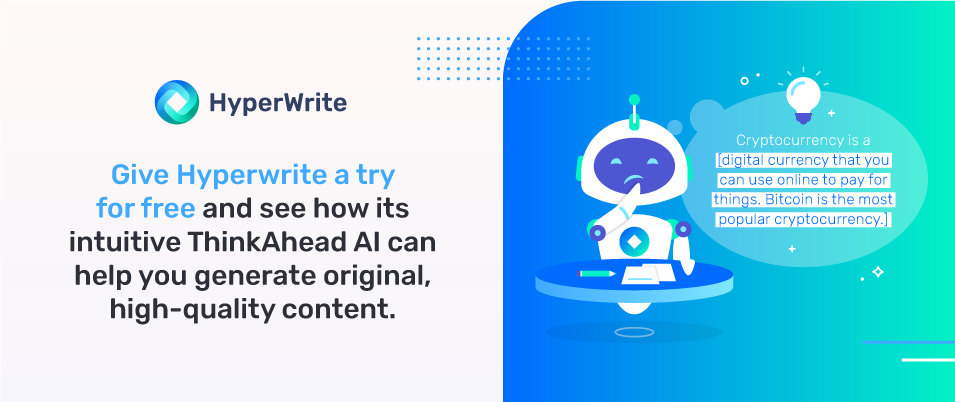Artificial intelligence is changing the world.
No, robot servants haven’t become a household staple (yet).
But AI is helping everyday people in ways you might not expect. From Netflix recommending your next series, to Google Maps analyzing traffic and construction detours to find your best route, to your banking app translating the handwriting on your mobile check deposit.
One of the many ways AI is helping humans is the use of predictive text to aid writers in creating new content.

What is Predictive Writing?
Predictive text is an AI program that offers word suggestions to complete your sentences, thereby saving typing time and keystrokes. The feature has widely become a part of everyday use with smartphones.
Predictions are made based on the context of words that have already been typed in addition to other factors, such as learning from your habits and preferences over time and, in the case of more sophisticated AI software, direct input of certain topics and stylistic desires.

Predictive text algorithms became popular with the rise of mobile devices, but they’re not a new concept.
In fact, the first known instance can be traced back to the 1940s with the Chinese typewriter created by Lin Yutang, which included actuating keys that suggested characters to follow the one selected.
Early use of predictive text in mobile devices started before the first smartphone hit the market. When texting the word the on a phone’s keypad, a user would have to press 8 once to select t, 4 twice to select h, and 3 twice to select e.
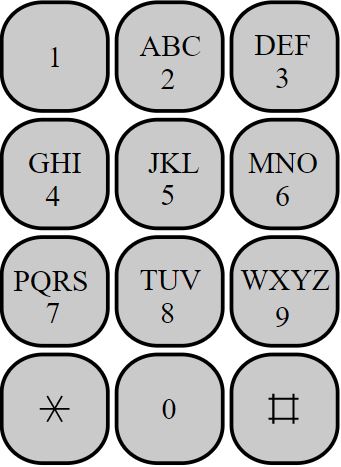
Source: Wikimedia Commons
That three-letter word takes five taps, which was highly inefficient, especially for longer words that required many more button pushes. The letters s and z both required four presses apiece.
But phones with T9 (text on nine keys) predictive functionality were able to associate key dictionary words and allow users to press 8-4-3 only once. The system understood that the user wanted “the” instead of “tgd.”
The most recognizable form of predictive writing came with Android’s predictive text bar in its 2012 Jelly Bean 4.1 release, with Apple following suit two years later with QuickType for iOS 8.
And now, AI predictive text is helping writers revolutionize the content marketing industry.
AI in Content Marketing: How to Harness Smart Predictive Text to Write High-Quality Content
You’ve probably played the predictive text game on your phone, right?
It starts with the first part of a sentence and relies on the predictive text feature to fill in the rest.
The game is known for providing hilariously nonsensical answers, which might lead you to believe that predictive text is unreliable for serious situations and everyday tasks.

But this level of predictive writing isn’t an accurate reflection of just how effective some AI programs can be. Content writers are partnering with AI to create high-quality articles, press releases, blog posts, and more. Yes… AI is even helping to write full novels.
With the help of artificial intelligence, writers are reducing brain blocks, saving time, and cutting back on the amount of caffeine needed to power through a writing session.
Hyperwrite is leading the industry with an intuitive, highly adaptable predictive text feature called ThinkAhead that is helping creators speed write and generate topics at record rates.
The AI program is the third iteration of Generative Pre-Trained Transformer (GPT-3) AI writing software.
Psst… you can try it out for free right now with a HyperWrite trial.
A Quick GPT-3 Tutorial
Here’s how it works:
1. Set the Parameters for a Project
This type of AI is most effective when it has a set of guidelines.
Unlike your phone’s predictive text, which has only the context of the words you’re currently typing and your text history (which may not be relevant to what you’re writing now), Hyperwrite is smart enough to adapt to the tone of a piece once you tell it what writing style to adopt.
From the dropdown menu, choose the type of content you need the AI to help you write:

2. Add a Description
The AI now has a grasp on the tone, but it still needs a topic so it can pull the appropriate data. You can help it out by providing a description of your project, including topics, themes, and keywords.
Inputting this information takes only a minute, and the AI is now fully equipped with everything it needs to write. It has the tone, context, and details to make smart decisions when recommending words and phrases to the writer.
ThinkAhead can be activated or deactivated, so make sure the switch is on if you want the predictive text to generate suggestions.
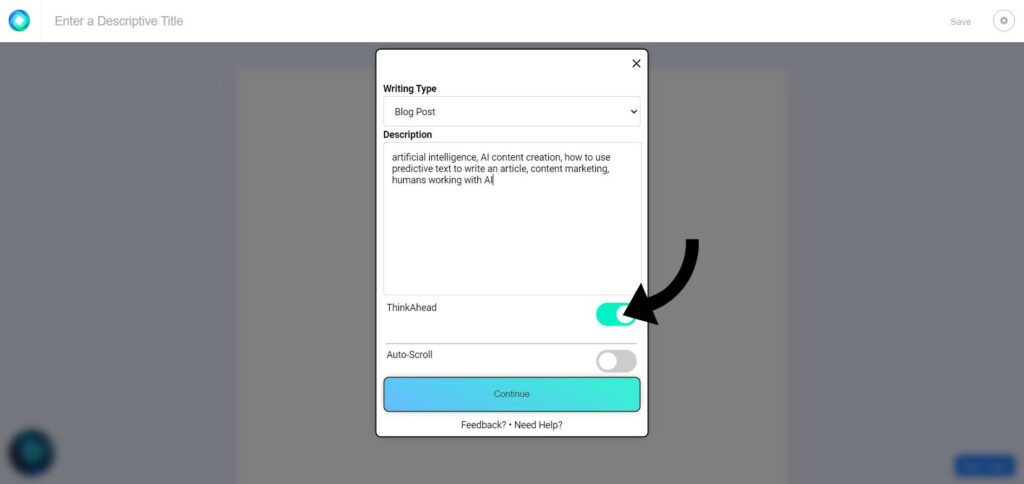
3. Write Away!
ThinkAhead will analyze a writer’s words and offer suggestions to continue.
The suggestions are better than a simple word-completion tool because they’re informed by what has already been written as well as the more in-depth project description you already provided.
The AI is smart enough to know when it should provide suggestions based on the writer’s style, topic, and the project itself.
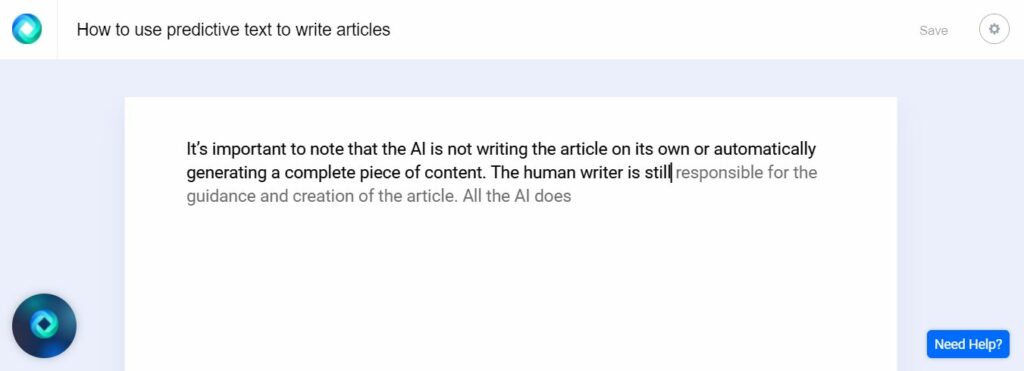
The Benefits of Using Predictive Text for Writing and Content Marketing
By 2024, the content marketing industry is expected to be worth more than $600 billion.
This means that content writers, who are already in high demand, are going to be more important than ever.
Content marketing offers a full list of benefits, including:
- High ROI: The biggest cost for consistent high-quality content is time. Because content marketing takes advantage of organic traffic, it’s a much less expensive option than PPC ads, giving businesses a greater return on their investment.
- Strong SEO performance: Search engines favor websites that provide useful content to viewers rather than sales pitches and low-quality articles. Having good content means a website will rank higher on search engine result pages.
- Increased web traffic: By providing information and solutions to readers, websites that rely on content marketing will attract more organic traffic and keep users on their sites for longer periods of time.
- Higher number of backlinks: Providing data, studies, and citable facts will lead to backlinks on other websites that quote your material.
- High consumer engagement: Readers are far more engaged when they are receiving valuable, actionable information that can educate them and help them solve problems.
- Future-proof strategy: SEO updates have consistently moved in the direction of consumer benefit rather than advertiser benefit. Unlike the outdated (and detrimental) practice of keyword stuffing, which was a “get rich quick” scheme that now penalizes websites, content marketing is sure to weather future trend shifts.
- Authoritative position within a niche: Providing good content establishes brands as experts within their industries, making consumers feel better about trusting them.
- Long lifespan for performance: Once content has been published, it can continue to bring in traffic years later if it’s still ranking well in search engines.
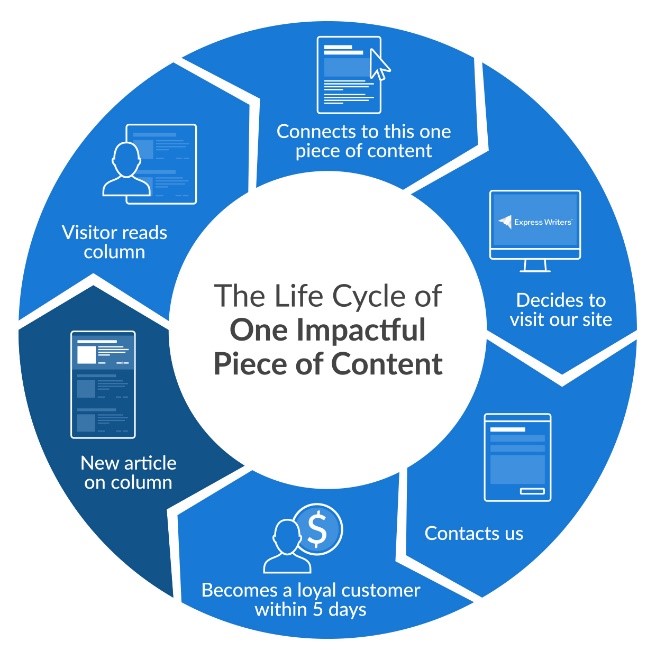
With all of these benefits, it’s no surprise that content writers have become a critical part of marketing strategies for a wide variety of brands and industries. Content creation is the single most outsourced activity.
But writing is a time-consuming process, and content creators are limited by how much they can produce.
This is where AI can help.
Predictive text operating at Hyperwrite’s level can help content creators write much more efficiently.
It saves time, generates ideas when a writer is stuck, helps to power through rough drafts and outlines, and makes it easy for the author to speed write.
Predictive text is unique because it can do all of this without distracting the user from the task at hand. It allows authors to focus on the creative part of writing while the AI takes care of the more mechanical parts of the process.
A few short years ago, AI wasn’t a helpful resource. The writing was stale and robotic, which wasn’t a big surprise considering a bot had indeed written the content.
But that wasn’t much help for the human writers. The time commitment and level of work needed to heavily edit such poor content made the tool more of a hinderance than a benefit.
Today is a different story.
AI has advanced by leaps and bounds in comparison to its early days. It’s constantly evolving and learning how to emulate natural human speech while generating 100% original content.
To be clear, this is not about getting an AI to write an article for you.
It’s about using AI to streamline the content writing process to help you, the human author, create better content.
You are still in control. You can choose to accept the predictive text or keep writing and see new suggestions as you steer into a different direction.
With predictive text, writing content is as easy as writing a text message.
To Keep Up with the Future of Content Writing, Start by Adding AI to Your Toolbox Now
The content marketing industry is exploding, and the potential of predictive text and other AI applications is surging along with it.
Content writers who resist the change are going to be left behind.
We need to adapt with the technology, and Hyperwrite is leading the charge into the future. Its text prediction tool goes far beyond the predictive text you’re accustomed to using on your mobile device.
Feeling doubtful about an AI’s ability to write like a human? About 50% of this article was written by Hyperwrite’s AI with ThinkAhead predictive text and human guidance.
Would you have guessed that an artificial intelligence played such a vital role?
Give Hyperwrite a try for free and see how its intuitive ThinkAhead AI can help you generate original, high-quality content.
